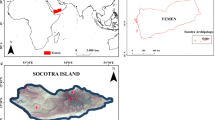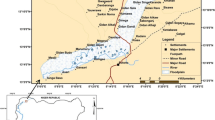Abstract
The presence of floating islands is a unique characteristic of Loktak Lake. Floating islands play a significant role in ecosystem services and ecological processes and functioning. Rapid urbanization, industrialization, and a demand for more resources have led to changes in the landscape patterns at Loktak Lake in past three decades, thereby degrading and threatening the fragile ecosystem. The aim of the present study is to assess the changes in land use practices of the Phumdis by analyzing data from the past 38 years with remote sensing techniques. Landsat images from 1977, 1988, 1999 and an Indian remote sensing image from 2015 were used to assess the land use/land cover changes. The methodology adopted is a supervised classification using the maximum likelihood technique in ERDAS software. Five land used classes were employed: open water bodies, agricultural areas, Phumdis with thick vegetation, and Phumdis with thin vegetation and settlements. The results indicate that the highest loss of land used class was in Phumdis with thin vegetation (49.38 km2) followed by Phumdis with thick vegetation (8.59 km2), while there was an overall increase in open water bodies (27.00 km2), agricultural areas (25.33 km2), and settlement (5.75 km2). Our study highlights the loss of floating islands from the Loktak as a major concern that will lead to the destruction of the only “floating national park in the world.” There is a high probability of extinction of the Sangai, an important keystone species found in the Indo-Burma biodiversity hotspot, if floating islands are not protected through sustainable development.








Similar content being viewed by others
References
Anon, (2011). National Wetland Atlas. SAC/EPSA/ABHG/NWIA/ATLAS/34/2011. Space Applications Centre (ISRO), (pp. 310). Ahmedabad.
Asmala, A. (2012). Analysis of maximum likelihood classification on multispectral data. Applied Mathematical Sciences, 6(129–132), 6425–6436.
Asselman, N. E., & Middelkoop, H. (1995). Floodplain sedimentation: quantities, patterns and processes. Earth Surface Processes and Landforms, 20(6), 481–499. https://doi.org/10.1002/esp.3290200602.
Berlanga-Robles, C. A., & Ruiz-Luna, A. (2002). Land use mapping and change detection in the coastal zone of northwest Mexico using remote sensing techniques. Journal of Coastal Research, 18, 514–522.
Bhuvaneswari, K., Dhamotharan, R., & Radhakrishnan, N. (2011). Remote sensing satellite data for coastal ecosystem and human interaction—a case study in Tamil Nadu, India. International Journal of Computer Information Systems, 2(4), 77–81.
Kangabam, R. D., & Govindaraju, M. (2017). Anthropogenic activity-induced water quality degradation in the Loktak lake, a Ramsar site in the Indo-Burma biodiversity hotspot. Environmental Technology. https://doi.org/10.1080/09593330.2017.1378267.
Davidson, N. C. (2014). How much wetland has the world lost? Long-term and recent trends in global wetland area. Marine and Freshwater Research, 65(10), 934–941. https://doi.org/10.1071/MF14173.
Dewan, A. M., & Yamaguchi, Y. (2009). Land use and land cover change in Greater Dhaka, Bangladesh: Using remote sensing to promote sustainable urbanization. Applied Geography, 29(3), 390–340. https://doi.org/10.1016/j.apgeog.2008.12.005.
Devi, N. B. (1993). Phytosociology, primary production and nutrient status of macrophytes of Loktak lake, Manipur (doctoral dissertation, Ph. D. Thesis, Manipur University, Manipur. India).
Foley, J. A., DeFries, R., Asner, G. P., Barford, C., Bonan, G., Carpenter, S. R., et al. (2005). Global consequences of land use. Science, 309(5734), 570–574. https://doi.org/10.1126/science.1111772.
Frohn, R. C., Reif, M., Lane, C., & Autrey, B. (2009). Satellite remote sensing of isolated wetlands using object-oriented classification of Landsat-7 data. Wetlands, 29(3), 931–941. https://doi.org/10.1672/08-194.1.
Fukushima, T., Takahashi, M., Matsushita, B., & Okanishi, Y. (2007). Land use/cover change and its drivers: a case in the watershed of Lake Kasumigaura, Japan. Landscape and Ecological Engineering, 3(1), 21–31. https://doi.org/10.1007/s11355-006-0008-6.
Galatowitsch, S. M., Whited, D. C., Lehtinen, R., Husveth, J., & Schik, K. (2000). The vegetation of wet meadows in relation to their land-use. Environmental Monitoring and Assessment, 60(2), 121–144. https://doi.org/10.1023/A:1006159028274.
Garg, J. K., Singh, T. S., & Murthy, T. V. R. (1998). Wetlands of India. Project Report: RSAM. SAC/RESA/PR/01/98, 1998, (pp. 239). Space Applications Centre (ISRO), Ahmedabad.
Guerrero, G., Masera, O., & Mas, J. F. (2008). Land use/land cover change dynamics in the Mexican highlands: current situation and long term scenarios. Modelling Environmental Dynamics, 57–76. https://doi.org/10.1007/978-3-540-68498-5_2.
Hegazy, I. R., & Kaloop, M. R. (2015). Monitoring urban growth and land use change detection with GIS and remote sensing techniques in Daqahlia governorate Egypt. International Journal of Sustainable Built Environment, 4(1), 117–124. https://doi.org/10.1016/j.ijsbe.2015.02.005.
Jacob, M., Romeyns, L., Frankl, A., Asfaha, T., Beeckman, H., & Nyssen, J. (2016). Land use and cover dynamics since 1964 in the afro-alpine vegetation belt: Lib Amba Mountain in North Ethiopia. Land Degradation & Development, 27(3), 641–653. https://doi.org/10.1002/ldr.2396.
Jensen, J. R., Rutchey, K., Koch, M. S., & Narumalani, S. (1995). Inland wetland change detection in the Everglades Water Conservation Area 2A using a time series of normalized remotely sensed data. Photogrammetric Engineering and Remote Sensing, 61(2), 199–209.
Kangabam, R. D., Bhoominathan, S. D., Kanagaraj, S., & Govindaraju, M. (2017). Development of a water quality index (WQI) for the Loktak Lake in India. Applied Water Science, 7(6), 2907–2918. https://doi.org/10.1007/s13201-017-0579-4.
Klemas, V. (2011). Remote sensing of wetlands: case studies comparing practical techniques. Journal of Coastal Research, 27(3), 418–427. https://doi.org/10.2112/JCOASTRES-D-10-00174.1.
Lambin, E. F., Turner, B. L., Geist, H. J., Agbola, S. B., Angelsen, A., Bruce, J. W., & George, P. (2001). The causes of land-use and land-cover change: moving beyond the myths. Global Environmental Change, 11(4), 261–269. https://doi.org/10.1016/S0959-3780(01)00007-3.
Li, X. (1996). A review of the international researches on land use/land cover change. Acta Geographica Sinica-Chinese Edition, 51, 558–565.
Liu, J., Kuang, W., Zhang, Z., Xu, X., Qin, Y., Ning, J., & Wu, S. (2014). Spatiotemporal characteristics, patterns, and causes of land-use changes in China since the late 1980s. Journal of Geographical Sciences, 24(2), 195–210. https://doi.org/10.1007/s11442-014-1082-6.
Lowicki, D. (2008). Land use changes in Poland during transformation: Case study of Wielkopolska region. Landscape and Urban Planning, 87(4), 279–288. https://doi.org/10.1016/j.landurbplan.2008.06.010.
Luo, G. P., Zhou, C. H., Chen, X., & Li, Y. (2008). A methodology of characterizing status and trend of land changes in oases: a case study of Sangong River watershed, Xinjiang, China. Journal of Environmental Management, 88(4), 775–783. https://doi.org/10.1016/j.jenvman.2007.04.003.
Nagabhatla, N., Wickramasuriya, R., Prasad, N., & Finlayson, C. M. (2010). A multi-scale geospatial study of wetlands distribution and agricultural zones, and the case of India. Tropical Conservation Science, 3(3), 344–360. https://doi.org/10.1177/194008291000300308.
National Wetland Atlas (2011). SAC/EPSA/ABHG/NWIA/ATLAS/34/2011. Space Applications Centre (ISRO), (pp. 310) Ahmedabad, India.
MacKay, H., Finlayson, C. M., Fernandez-Prieto, D., Davidson, N., Pritchard, D., & Rebelo, L. M. (2009). The role of earth observation (EO) technologies in supporting implementation of the Ramsar Convention on Wetlands. Journal of Environmental Management, 90(7), 2234–2242. https://doi.org/10.1016/j.jenvman.2008.01.019.
MacAlister, C., & Mahaxay, M. (2009). Mapping wetlands in the Lower Mekong Basin for wetland resource and conservation management using Landsat ETM images and field survey data. Journal of Environmental Management, 90(7), 2130–2137. https://doi.org/10.1016/j.jenvman.2007.06.031.
Maktav, D., Erbek, F. S., & Jürgens, C. (2005). Remote sensing of urban areas. International Journal of Remote Sensing, 26(4), 655–659. https://doi.org/10.1080/01431160512331316469.
Manipur population Census Report. Census India Report (2011) Available from http://www.censusindia.gov.in/ Accessed September 2014.
Meitei, M. D., & Prasad, M. N. V. (2015). Phoomdi—a unique plant biosystem of Loktak lake, Manipur, North-East India: Traditional and ecological knowledge. Plant Biosystems—An International Journal Dealing with all Aspects of Plant Biology, 149(4), 777–787. https://doi.org/10.1080/11263504.2013.870250.
Muchoney, D. M., & Haack, B. N. (1994). Change detection for monitoring forest defoliation. Photogrammetric Engineering and Remote Sensing, 60(10), 1243–1251.
Ozesmi, S. L., & Bauer, M. E. (2002). Satellite remote sensing of wetlands. Wetlands Ecology and Management, 10(5), 381–402. https://doi.org/10.1023/A:1020908432489.
Papastergiadou, E. S., Retalis, A., Kalliris, P., & Georgiadis, T. (2007). Land use changes and associated environmental impacts on the Mediterranean shallow Lake Stymfalia, Greece. Hydrobiologia, 584(1), 361–372. https://doi.org/10.1007/s10750-007-0606-9.
Phillips, R. L., Beeri, O., & DeKeyser, E. S. (2005). Remote wetland assessment for Missouri Coteau prairie glacial basins. Wetlands, 25(2), 335–349.
Rai, S. C., & Raleng, A. (2012). The impacts of land-use/cover change on Loktak lake water quality in north-eastern region, India. Asian Journal of Water, Environment and Pollution, 9(1), 13–23.
Rajiv, D.K., (2016). A study on landscape limnology of Loktak Lake in Indo-Burma biodiversity hotspot region. Doctoral dissertation PhD Thesis, Bharathidasan University. Tiruchirappalli, India).
Rajkumari, D. S., Srivastava, P., & Gupta, A. (2004). Catchments characterization of Loktak lake using remote sensing and geographical information system (GIS) techniques. Available from http://www.geospatialworld.net/article/catchment-characterization-of-loktak-lake-using-remote-sensing-and-gis/ Accessed September 2014.
Rani, M., Kumar, P., Yadav, M., & Hooda, R. S. (2011). Wetland assessment and monitoring using image processing techniques: a case study of Ranchi, India. Journal of Geographic Information System, 3(04), 345–350. https://doi.org/10.4236/jgis.2011.34032.
Rahman, M. T. U., Tabassum, F., Rasheduzzaman, M., Saba, H., Sarkar, L., Ferdous, J., et al. (2017). Temporal dynamics of land use/land cover change and its prediction using CA-ANN model for southwestern coastal Bangladesh. Environmental Monitoring and Assessment, 189(11), 565. https://doi.org/10.1007/s10661-017-6272-0.
Ramachandra, T. V., & Kumar, U. (2008). Wetlands of greater Bangalore, India: automatic delineation through pattern classifiers. Electronic Green Journal, 1(26). Available from http://escholarship.org/uc/item/3dp0q8f2 Accessed March 2014.
Ramsar report on Montreux Record (2013) Available from http://www.ramsar.org/cda/en/ramsar-documents-montreux/main/ramsar/1-31-18_4000_0 Accessed August 2015.
Shalaby, A., & Tateishi, R. (2007). Remote sensing and GIS for mapping and monitoring land cover and land-use changes in the northwestern coastal zone of Egypt. Applied Geography, 27(1), 28–41. https://doi.org/10.1016/j.apgeog.2006.09.004.
Singh, M. P. (1996). Ecology of Loktak lake with special reference to fish and fisheries of the lake. (Doctoral dissertation, PhD Thesis, Manipur University, Manipur. India).
Singh, O. K. (1997). Agriculture in floating fields on Loktak Lake, Manipur. Current Science, 72(12), 902–903.
Singh, A. (1986). Change detection in the tropical forest environment of northeastern India using Landsat, Remote sensing and tropical land management (pp. 237–254). New York: John Wiley and Sons Ltd.
Singh, T. H., Singh, R. K. S., (1994). Ramsar sites of India, Loktak lake. New Delhi, WWF-India.
The Hindu (2011). Loktak hydro project turns agricultural land into swamps. http://www.thehindu.com/news/national/other-states/loktak-hydro-project-turns-agricultural-land-into-swamps/article2554768.ece Accessed August 2015.
Xu, Y., Luo, D., & Peng, J. (2011). Land use change and soil erosion in the Maotiao River watershed of Guizhou Province. Journal of Geographical Sciences, 21(6), 1138–1152. https://doi.org/10.1007/s11442-011-0906-x.
Zhang, B., Zhang, Q., Feng, Q., Cui, B., & Zhang, S. (2017). Simulation of the spatial stresses due to territorial land development on Yellow River Delta Nature Reserve using a GIS-based assessment model. Environmental Monitoring and Assessment, 189(7), 331. https://doi.org/10.1007/s10661-017-6038-8.
Zhao, H., Cui, B., Zhang, H., Fan, X., Zhang, Z., & Lei, X. (2010). A landscape approach for wetland change detection (1979-2009) in the Pearl River Estuary. Procedia Environmental Sciences, 2, 1265–1278. https://doi.org/10.1016/j.proenv.2010.10.137.
Acknowledgments
Authors are thankful to UGC-SAP and DST–FIST for the instrumentation facility provided required for the study. The first author thanks the local people living in and around Loktak Lake who helped during the fieldwork.
Funding
This research work was supported with funding from the Society of Wetland Scientists, USA, through a Ramsar Research Grant and by the Ocean Park Conservation Foundation in Hong Kong through a conservation research grant.
Author information
Authors and Affiliations
Corresponding author
Rights and permissions
About this article
Cite this article
Kangabam, R.D., Selvaraj, M. & Govindaraju, M. Spatio-temporal analysis of floating islands and their behavioral changes in Loktak Lake with respect to biodiversity using remote sensing and GIS techniques. Environ Monit Assess 190, 118 (2018). https://doi.org/10.1007/s10661-018-6485-x
Received:
Accepted:
Published:
DOI: https://doi.org/10.1007/s10661-018-6485-x




